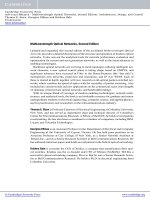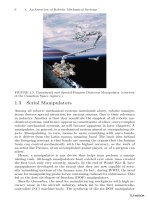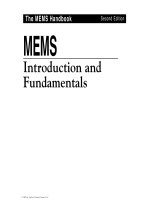Enzymes (second edition)
Bạn đang xem bản rút gọn của tài liệu. Xem và tải ngay bản đầy đủ của tài liệu tại đây (7.26 MB, 411 trang )
Enzymes: A Practical Introduction to Structure, Mechanism, and Data Analysis.
Robert A. Copeland
Copyright 2000 by Wiley-VCH, Inc.
ISBNs: 0-471-35929-7 (Hardback); 0-471-22063-9 (Electronic)
ENZYMES
SECOND EDITION
ENZYMES
A Practical Introduction
to Structure, Mechanism,
and Data Analysis
SECOND EDITION
Robert A. Copeland
A JOHN WILEY & SONS, INC., PUBLICATION
New York / Chichester / Weinheim / Brisbane / Singapore / Toronto
Designations used by companies to distinguish their products are often claimed as trademarks. In
all instances where John Wiley & Sons, Inc., is aware of a claim, the product names appear in
initial capital or . Readers, however, should contact the appropriate
companies for more complete information regarding trademarks and registration.
Copyright " 2000 by Wiley-VCH, Inc. All rights reserved.
No part of this publication may be reproduced, stored in a retrieval system or transmitted in any
form or by any means, electronic or mechanical, including uploading, downloading, printing,
decompiling, recording or otherwise, except as permitted under Sections 107 or 108 of the 1976
United States Copyright Act, without the prior written permission of the Publisher. Requests
to the Publisher for permission should be addressed to the Permissions Department, John
Wiley & Sons, Inc., 605 Third Avenue, New York, NY 10158-0012, (212) 850-6011, fax (212)
850-6008, E-Mail: PERMREQ!WILEY.COM.
This publication is designed to provide accurate and authoritative information in regard to the
subject matter covered. It is sold with the understanding that the publisher is not engaged in
rendering professional services. If professional advice or other expert assistance is required, the
services of a competent professional person should be sought.
ISBN 0-471-22063-9
This title is also available in print as ISBN 0-471-35929-7.
For more information about Wiley products, visit our web site at www.Wiley.com.
To Clyde Worthen
for teaching me all the important lessons:
arigato sensei.
And to Theodore (Doc) Janner
for stoking the fire.
CONTENTS
Preface
xi
Acknowledgments
xiii
Preface to the First Edition
xv
1 A Brief History of Enzymology
1
1.1 Enzymes in Antiquity / 2
1.2 Early Enzymology / 3
1.3 The Development of Mechanistic Enzymology / 4
1.4 Studies of Enzyme Structure / 5
1.5 Enzymology Today / 7
1.6 Summary / 8
References and Further Reading / 10
2 Chemical Bonds and Reactions in Biochemistry
11
2.1 Atomic and Molecular Orbitals / 11
2.2 Thermodynamics of Chemical Reactions / 23
2.3 Acid—Base Chemistry / 29
2.4 Noncovalent Interactions in Reversible Binding / 32
2.5 Rates of Chemical Reactions / 35
2.6 Summary / 41
References and Further Reading / 41
3 Structural Components of Enzymes
3.1
3.2
3.3
3.4
3.5
42
The Amino Acids / 42
The Peptide Bond / 53
Amino Acid Sequence or Primary Structure / 55
Secondary Structure / 57
Tertiary Structure / 62
vii
viii
CONTENTS
3.6 Subunits and Quaternary Structure / 65
3.7 Cofactors in Enzymes / 68
3.8 Summary / 71
References and Further Reading / 74
4 Protein‒Ligand Binding Equilibria
76
The Equilibrium Dissociation Constant, K / 76
!
The Kinetic Approach to Equilibrium / 78
Binding Measurements at Equilibrium / 80
Graphic Analysis of Equilibrium Ligand Binding Data / 88
Equilibrium Binding with Ligand Depletion (Tight Binding
Interactions) / 94
4.6 Competition Among Ligands for a Common Binding Site / 95
4.7 Experimental Methods for Measuring Ligand Binding / 96
4.8 Summary / 107
References and Further Reading / 108
4.1
4.2
4.3
4.4
4.5
5 Kinetics of Single-Substrate Enzyme Reactions
109
5.1 The Time Course of Enzymatic Reactions / 109
5.2 Effects of Substrate Concentration on Velocity / 111
5.3 The Rapid Equilibrium Model of Enzyme Kinetics / 113
5.4 The Steady State Model of Enzyme Kinetics / 115
5.5 The Significance of k and K / 120
"#$
%
5.6 Experimental Measurement of k and K / 124
"#$
%
5.7 Other Linear Transformations of Enzyme Kinetic Data / 133
5.8 Measurements at Low Substrate Concentrations / 136
5.9 Deviations from Hyperbolic Kinetics / 137
5.10 Transient State Kinetic Measurements / 141
5.11 Summary / 145
References and Further Reading / 145
6 Chemical Mechanisms in Enzyme Catalysis
6.1
6.2
6.3
6.4
6.5
146
Substrate—Active Site Complementarity / 147
Rate Enhancement Through Transition State Stabilization / 151
Chemical Mechanisms for Transition State Stabilization / 154
The Serine Proteases: An Illustrative Example / 178
Enzymatic Reaction Nomenclature / 184
ix
CONTENTS
6.6 Summary / 186
References and Further Reading / 186
7 Experimental Measures of Enzyme Activity
188
7.1 Initial Velocity Measurements / 188
7.2 Detection Methods / 204
7.3 Separation Methods in Enzyme Assays / 223
7.4 Factors Affecting the Velocity of Enzymatic Reactions / 238
7.5 Reporting Enzyme Activity Data / 257
7.6 Enzyme Stability / 258
7.7 Summary / 263
References and Further Reading / 263
8 Reversible Inhibitors
266
8.1 Equilibrium Treatment of Reversible Inhibition / 268
8.2 Modes of Reversible Inhibition / 270
8.3 Graphic Determination of Inhibitor Type / 273
8.4 Dose—Response Curves of Enzyme Inhibition / 282
8.5 Mutually Exclusive Binding of Two Inhibitors / 287
8.6 Structure—Activity Relationships and Inhibitor Design / 291
8.6 Summary / 303
References and Further Reading / 303
9 Tight Binding Inhibitors
305
9.1
9.2
9.3
9.4
Identifying Tight Binding Inhibition / 305
Distinguishing Inhibitor Type for Tight Binding Inhibitors / 307
Determining K for Tight Binding Inhibitors / 310
&
Use of Tight Binding Inhibitors to Determine Active Enzyme
Concentration / 313
9.5 Summary / 315
References and Further Reading / 316
10 Time-Dependent Inhibition
10.1 Progress Curves for Slow Binding Inhibitors / 321
10.2 Distinguishing Between Slow Binding Schemes / 325
10.3 Distinguishing Between Modes of Inhibitor Interaction with
Enzyme / 330
318
x
CONTENTS
10.4 Determining Reversibility / 332
10.5 Examples of Slow Binding Enzyme Inhibitors / 334
10.6 Summary / 348
References and Further Reading / 349
11 Enzyme Reactions with Multiple Substrates
350
11.1 Reaction Nomenclature / 350
11.2 Bi Bi Reaction Mechanisms / 352
11.3 Distinguishing Between Random and Compulsory Ordered
Mechanisms by Inhibition Pattern / 357
11.4 Isotope Exchange Studies for Distinguishing Reaction
Mechanisms / 360
11.5 Using the King—Altman Method to Determine Velocity
Equations / 362
11.6 Summary / 364
References and Further Reading / 366
12 Cooperativity in Enzyme Catalysis
367
12.1 Historic Examples of Cooperativity and Allostery in Proteins / 368
12.2 Models of Allosteric Behavior / 373
12.3 Effects of Cooperativity on Velocity Curves / 379
12.4 Sigmoidal Kinetics for Nonallosteric Enzymes / 382
12.5 Summary / 383
References and Further Reading / 384
Appendix I. Suppliers of Reagents and Equipment for
Enzyme Studies
Appendix II.
Index
Useful Computer Software and Web Sites
for Enzyme Studies
385
387
391
PREFACE
In the four years since the first edition of Enzymes was published, I have been
delighted to learn of the wide acceptance of the book throughout the biochemical community, and particularly in the pharmaceutical community. During this
time a number of colleagues have contacted me to express their views on the
value of the text, and importantly to make suggestions for improvements to the
content and presentation of some concepts. I have used the first edition as a
teaching supplement for a course in which I lecture at the University of
Pennsylvania School of Medicine. From my lecture experiences and from
conversations with students, I have developed some new ideas for how to better
explain some of the concepts in the text and have identified areas that deserve
expanded coverage. Finally, while the first edition has become popular with
students and industrial scientists, some of my academic colleagues have
suggested a need for a more in-depth treatment of chemical mechanisms in
enzymology.
In this second edition I have refined and expanded the coverage of many of
the concepts in the text. To help the reader better understand some of the
interactions between enzymes and their substrates and inhibitors, a new
chapter on protein—ligand binding equilibria has been added (Chapter 4). The
chapters on chemical mechanisms in enzyme catalysis (Chapter 6) and on
experimental measures of enzyme activity (Chapter 7) have been expanded
significantly. The discussions of enzyme inhibitors and multiple substrate
reactions (Chapters 8 through 11) have been refined, and in some cases
alternative treatments have been presented. In all of this, however, I have tried
to maintain the introductory nature of the book. There are many excellent
advanced texts on catalysis, enzyme mechanisms, and enzyme kinetics, but the
level at which these are generally written is often intimidating to the beginner.
Hence, as stated in the preface to the first edition, this book is intended to serve
as a mechanism for those new to the field of enzymology to develop a
reasonable understanding of the science and experimental methods, allowing
them to competently begin laboratory studies with enzymes. I have continued
to rely on extensive citations to more advanced texts and primary literature as
a means for the interested reader to go beyond the treatments offered here and
delve more deeply into specific areas of enzymology.
xi
xii
PREFACE
In developing this second edition I have had fruitful conversations and
advice from a number of colleagues. In particular, I wish to thank Andy Stern,
Ross Stein, Trevor Penning, Bill Pitts, John Blanchard, Dennis Murphy, and
the members of the Chemical Enzymology Department at the DuPont Pharmaceuticals Company. As always, the love and support of my family has been
most important in making this work possible.
R A. C
Wilmington, Delaware
ACKNOWLEDGMENTS
It is a great pleasure for me to thank the many friends and coworkers who
have helped me in the preparation of this work. Many of the original lecture
notes from which this text has developed were generated while I was teaching
a course on biochemistry for first-year medical students at the University of
Chicago, along with the late Howard S. Tager. Howard contributed greatly to
my development as a teacher and writer. His untimely death was a great loss
to many of us in the biomedical community; I dearly miss his guidance and
friendship.
As described in the Preface, the notes on which this text is based were
significantly expanded and reorganized to develop a course of enzymology for
employees and students at the DuPont Merck Pharmaceutical Company. I am
grateful for the many discussions with students during this course, which
helped to refine the final presentation. I especially thank Diana Blessington for
the original suggestion of a course of this nature. That a graduate-level course
of this type could be presented within the structure of a for-profit pharmaceutical company speaks volumes for the insight and progressiveness of the
management of DuPont Merck. I particularly thank James M. Trzaskos,
Robert C. Newton, Ronald L. Magolda, and Pieter B. Timmermans for not
only tolerating, but embracing this endeavor.
Many colleagues and coworkers contributed suggestions and artwork for
this text. I thank June Davis, Petra Marchand, Diane Lombardo, Robert
Lombardo, John Giannaras, Jean Williams, Randi Dowling, Drew Van Dyk,
Rob Bruckner, Bill Pitts, Carl Decicco, Pieter Stouten, Jim Meek, Bill DeGrado, Steve Betz, Hank George, Jim Wells, and Charles Craik for their
contributions.
Finally, and most importantly, I wish to thank my wife, Nancy, and our
children, Lindsey and Amanda, for their constant love, support, and encouragement, without which this work could not have been completed.
xiii
PREFACE
TO THE FIRST EDITION
The latter half of this century has seen an unprecedented expansion in our
knowledge and use of enzymes in a broad range of basic research and industrial
applications. Enzymes are the catalytic cornerstones of metabolism, and as such
are the focus of intense research within the biomedical community. Indeed
enzymes remain the most common targets for therapeutic intervention within
the pharmaceutical industry. Since ancient times enzymes also have played
central roles in many manufacturing processes, such as in the production of
wine, cheese, and breads. During the 1970s and 1980s much of the focus of the
biochemical community shifted to the cloning and expression of proteins
through the methods of molecular biology. Recently, some attention has shifted
back to physicochemical characterization of these proteins, and their interactions with other macromolecules and small molecular weight ligands (e.g.,
substrates, activators, and inhibitors). Hence, there has been a resurgence of
interest in the study of enzyme structures, kinetics, and mechanisms of catalysis.
The availability of up-to-date, introductory-level textbooks, however, has
not kept up with the growing demand. I first became aware of this void while
teaching introductory courses at the medical and graduate student level at the
University of Chicago. I found that there were a number of excellent advanced
texts that covered different aspects of enzymology with heavy emphasis on the
theoretical basis for much of the science. The more introductory texts that I
found were often quite dated and did not offer the blend of theoretical and
practical information that I felt was most appropriate for a broad audience of
students. I thus developed my own set of lecture notes for these courses,
drawing material from a wide range of textbooks and primary literature.
In 1993, I left Chicago to focus my research on the utilization of basic
enzymology and protein science for the development of therapeutic agents to
combat human diseases. To pursue this goal I joined the scientific staff of the
DuPont Merck Pharmaceutical Company. During my first year with this
company, a group of associate scientists expressed to me their frustration at
being unable to find a textbook on enzymology that met their needs for
guidance in laboratory protocols and data analysis at an appropriate level and
xv
xvi
PREFACE TO THE FIRST EDITION
at the same time provide them with some relevant background on the scientific
basis of their experiments. These dedicated individuals asked if I would prepare
and present a course on enzymology at this introductory level.
Using my lecture notes from Chicago as a foundation, I prepared an
extensive set of notes and intended to present a year-long course to a small
group of associate scientists in an informal, over-brown-bag-lunch fashion.
After the lectures had been announced, however, I was shocked and delighted
to find that more than 200 people were registered for this course! The makeup
of the student body ranged from individuals with associate degrees in medical
technology to chemists and molecular biologists who had doctorates. This
convinced me that there was indeed a growing interest and need for a new
introductory enzymology text that would attempt to balance the theoretical
and practical aspects of enzymology in such a way as to fill the needs of
graduate and medical students, as well as research scientists and technicians
who are actively involved in enzyme studies.
The text that follows is based on the lecture notes for the enzymology course
just described. It attempts to fill the practical needs I have articulated, while
also giving a reasonable introduction to the theoretical basis for the laboratory
methods and data analyses that are covered. I hope that this text will be of use
to a broad range of scientists interested in enzymes. The material covered
should be of direct use to those actively involved in enzyme research in
academic, industrial, and government laboratories. It also should be useful as
a primary text for senior undergraduate or first-year graduate course, in
introductory enzymology. However, in teaching a subject as broad and
dynamic as enzymology, I have never found a single text that would cover all
of my students’ needs; I doubt that the present text will be an exception. Thus,
while I believe this text can serve as a useful foundation, I encourage faculty
and students to supplement the material with additional readings from the
literature cited at the end of each chapter, and the primary literature that is
continuously expanding our view of enzymes and catalysis.
In attempting to provide a balanced introduction to enzymes in a single,
readable volume I have had to present some of the material in a rather cursory
fashion; it is simply not possible, in a text of this format, to be comprehensive
in such an expansive field as enzymology. I hope that the literature citations
will at least pave the way for readers who wish to delve more deeply into
particular areas. Overall, the intent of this book is to get people started in the
laboratory and in their thinking about enzymes. It provides sufficient experimental and data handling methodologies to permit one to begin to design and
perform experiments with enzymes, while at the same time providing a
theoretical framework in which to understand the basis of the experimental
work. Beyond this, if the book functions as a stepping-stone for the reader to
move on to more comprehensive and in-depth treatments of enzymology, it will
have served its purpose.
R A. C
Wilmington, Delaware
‘‘All the mathematics in the world is no substitute for a
reasonable amount of common sense.’’
W. W. Cleland
INDEX
Absorption spectroscopy, 189, 205
errors in, 210
Acid-base catalysis, 155, 164
pH effects on, 166
Acid-base chemistry, 29
of amino acid side chains, 45, 48
Activation energy, 27, 152
Active site complementarity, 147
Active site preorganization, 155, 176
Active site structure, 147
Active site titration, 197, 313
Active site triad of serine proteases, 63,
178
Activity staining, in gel electrophoresis,
234
Acyl-enzyme intermediates, 158, 162, 179
Affinity labeling, 346
AIDS, 9, 67
Allosteric constant, 377
Allosteric effectors, 368
Allostery, 367
Alpha carbon, of amino acids, 42
Alpha helix, 58
Alpha-aminoboronate peptides, as
inhibitors of serine proteases, 335
Alpha-amylase, 3
Amino acid sequence, 7, 55
Amino acids, 42
physicochemical properties of, 43
side chain structures of, 44
Amino terminus, 55
Ancient references to enzymes, 2
Anion and polyanion binding in
proteins, 50
Antibodies, 178, 233
Apoenzyme, 69
Approximation of reactants, 155
Aromaticity, 20
Arrhenius equation, 28, 249
Arrhenius plots, 250
Aryl azides, 346
Aspartate carbamoyltransferase, 373
Aspirin, as an inhibitor of prostaglandin
synthase, 335
Atomic orbitals, 11
ATPases, 52
Aufbau principle, 14
Autoradiography, 219, 227
Beer’s law, 206
Benzophenones, 346
Beta pleated sheet, 60
Beta turns, 61
Bi bi reactions, 352
Bohr model of atoms, 12
Bond lengths, of peptide components, 53
Bonding and antibonding orbitals, 15
Briggs and Haldane steady state
approach, 115
Bromoacetamido-affinity labels, as
inhibitors of prostaglandin
synthase, 336
Broănsted-Lowry acids and bases, 29, 48
Broănsted equations, 167
391
392
INDEX
Broănsted plots, 160, 169
Buffering capacity, 31
Buffers used in enzyme assays, 242
Burst phase kinetics, 159, 196
Carbonic anhydrase, 49
Carboxyl terminus, 56
Carboxypeptidase, 179
Carrier proteins, 260
Catalytic antibodies, 178
Cation and metal binding in proteins, 49
Chemical bonds, 11
Chemical mechanisms of catalysis, 146
Chemical modification, 341
Cheng and Prusoff equations, 285
Chromatography, 102, 224
Chymotrypsin, 63, 179
Cis-prolyl bonds in enzymes, 55
Cis-trans peptide bonds, 54
Coenzymes, see Cofactors
Cofactors, 68
effects on velocity, 240
Comformational distortion, 170
Competitive binding, 95
Competitive inhibitors, 273, 358
Compulsory ordered reactions, 354
Computer software for enzyme studies,
387
Concerted transition model of
cooperativity, 373
Conjugate bases, 29
Consumer products, use of enzymes in, 1
Continuous assays, 199
Controls, importance of in experimental
measurements, 202
Coomassie brilliant blue, 231
Cooperativity, 86, 139, 367
effects on velocity curves, 139, 379
in inhibitor binding, 381
models of, 373
Cooperativity index, 380
Coulombic attractive forces, 32
Coupled reactions, 25, 190
Covalent catalysis, 158
Covalent modification, 50, 341
CPM (Counts per minute), 219
Curie (Ci), 219
Cytochrome c, 189
Cytochrome oxidase, 25, 185, 189
Deadend inhibition, 265, 358
Desalting columns, 224
Detection methods, 204
Digestion, 3
Dihydroorotate dehydrogenase, 9, 185,
190, 220, 235
Dihyrofolate reductase, 292, 300
Dipole moment, 34
Direct assays, 188
Discontinuous assays, 199
Disulfide bonds, 50
Dixon plots, 276, 309
Domains, 65
Dose-response curves, 282
Double displacement reactions, 355
Double reciprocal plots, 90, 128
use in determining inhibitor type,
273
Drugs, enzyme inhibitors as, 8
DPM (disintegrations per minute), 219
DuP697, 339
Eadie-Hofstee plots, 91, 133
Eisenthal-Cornish-Bowden plots, 134
Electron spin, 12
Electronic configuration, of elements
common in biological tissue, 15
Electronic state, 22
Electrophilic catalysis, 161
Electrophoresis, 230
Electrostatic interactions, 32
ELISA, 222
End point assays, 199
Enthalpy, 24
Entropy, 24
Enzyme Commission (EC) classification
system, 184
Enzyme Data Bank, 186
Enzyme concentration, effects on
velocity, 238
Enzyme reactions, general nomenclature
for, 184
Enzyme structure, 5, 42
in inhibitor design, 299
Enzyme, definition of, 4
Enzyme-inhibitor complex, 267
Enzyme-product complex, 113
Enzyme-substrate complexes, 113
Enzymes, as targets for drugs, 8
INDEX
Equilibrium binding, 76
Equilibrium dialysis, 97
Equilibrium dissociation constant, see
K
!
Equipment for enzyme studies, 385
E , see Taft steric parameter
!
Excited states, 22
Experimental measures of activity, 188
Extinction coefficient, 206
Feedback loops, in metabolic control,
370
Ficin, 2
Flavins, as cofactors in enzymes, 70
Fluorescence, 104, 211
resonance energy transfer, 213
polarization, 104
quenching, 213
errors in, 216
Flurbiprofen, 336
4,4!-dithioldipyridine, 51
Fractional activity, 283
Free energy ("G), 23
of binding, 77
Free energy diagrams, 27
Freeze-thaw cycling, effects on enzyme
stability, 259
General acid-base catalysis, 164
Glassware, protein adsorption to, 259
Global fitting of inhibition data, 282
Glycoproteins, 52
Glycosylation, 52
Graphic determination of K , 273
"
for competitive inhibitors, 273
for noncompetitive inhibitors, 278
for uncompetitive inhibitors, 280
GRID program, use in inhibitor design,
302
Ground state, 22
Guanidine hydrochloride, 63
Haldane relationship, 122
Hammett sigma constant, 294
Hanes-Woolf plots, 93, 134
Hemes, as cofactors in enzymes, 70
Hemoglobin, 56, 67, 368
R and T states of, 67, 370
Henderson equation, 311
393
Henderson-Hasselbalch equation, 31,
244
Henri-Michaelis-Menten equation, 5,
113
Heterotropic cooperativity, 368
Highest Occupied Molecular Orbital
(HOMO), 23
Hill coefficient, 139, 379
Hill equation, 139, 379
Hill plots, 140
HIV protease, 67
Holoenzyme, 69
Homer’s Iliad, 2
homology modeling, 301
homotropic cooperativity, 367
HPLC (high performance liquid
chromatography), 224
Hummel-Dreyer chromatography, 102
Hybrid orbitals, 17
Hydrogen bonding, 33
Hydrophobic interactions, 33
Hydrophobic parameter (#), 294
Hydrophobicity, 43, 294
Hyperbolic kinetics, 111
deviations from, 137
IC , 96, 282
"#
effects of substrate concentration on,
284
Immunoblotting, 233
Inactivation of enzymes, 260, 320
Index Medicus, 186
Indirect assays, 188
Indomethacin, 337
Induced fit model, 173
Induced strain model, 173
Inhibition, equilibrium treatement of,
268
Inhibitor design, 291
Inhibitor screening, 291
Inhibitors, reversible, 267
Initial velocity, 40, 199
measurements at low substrate
concentration, 136
Initiating reactions, 200
Inner filter effect, 216
International units, 257
Ion exchange chromatography, 229
Ion pairs, 32
394
INDEX
Irreversible inactivation, 328, 341
Isobolograms, 289
Isomerization, of enzymes, 320
Isotope effects, in characterization of
reaction transition state, 255
Isotope exchange, use in distinguishing
reaction mechanism, 360
Isotopes, effects on velocity, 253
k , 114
"#$
k /K , 122
"#$ %
K , 76
!
K , 267
&
k
, 328
&'$#"$
Kinases, 51
Kinetic approach to equilibrium, 78
Kinetic perfection, 123
Kinetics, hyperbolic, see Hyperbolic
kinetics
Kinetics, sigmoidal, 138, 379
Kinetics, steady state, 115
King-Altman method, 362
K , 118
%
graphic determination of, 124
k , for slow binding inhibitors, 322
()*
k , 78
(++
k , 78
('
K , 114
!
Kyte and Doolittle hydrophobicity
index for amino acid residues, 45
Lag phase, 191, 196, 250
Langmuir isotherm, 80
Lewis acids and bases, 29
Ligand, 76
Ligand Binding, 76
methods for measuring, 96
Ligand depletion, 94
Lineweaver Burk plots, see Double
reciprocal plots
Lock and key model, 4, 148
Lone pair electrons, 20
Lowest Unoccupied Molecular Orbital
(LUMO), 23
Mechanism-based inhibition, 321
Mefanamic acid, 338
Membrane filtration, 99, 224
Metalloproteases, 184, 215
Metals, as cofactors in enzymes, 49, 162
Methotrexate, 292, 300
Methyl thiazolyl tetrazolium, 235
Michaelis Menten equation, see HenriMichaelis-Menten equation
Microtiter plates, for spectroscopic
assays, 209
Mixed inhibitors, see Noncompetitive
inhibitors
Mixing of samples, 200
Molar absorptivity, see Extinction
coefficient
Molar refractivity, as a measure of steric
bulk, 294
Molecular biology, 7, 56, 172
Molecular dynamics, 301
Molecular orbitals, 15
Monod, Wyman, Changeux model of
cooperativity, 373
Morrison equation, 310
Multiple binding sites, 83
equivalent, 83
nonequivalent, 84
Multi-subunit enzymes, 66
Multisubstrate-utilizing enzyme, 350
Mutually exclusive inhibitor binding,
287
Myoglobin, 6, 369
NAD and NADP, as cofactors in
enzymes, 25, 71, 190
Native gel electrophoresis, 234
Negative cooperativity, 86, 139, 367
Nicotinamide adenine dinucleotide, see
NAD
Nitroblue tetrazolium, 235
Nitrocellulose, protein binding to, 99,
224, 233
NMR spectroscopy, 7, 266, 299
Nonbonding electrons, 20
Nonspecific binding, 86
Nonsteroidal anti-inflammatory drugs
(NSAIDs), 336
Noncompetitive inhibitors, 270
Noncovalent interactions, 32
Nonexclusive binding coefficient, 377
Nucleophilic catalysis, 160
Optical cells, 207
INDEX
Optical spectroscopy, 104, 205
Orbital angular momentum, 12
Orbital steering, 156
Papain, 2
Partial inhibitors, 272
Dixon plot for, 287
dose-response curves for, 287
Partition coefficient, 294
Pauli exclusion principle, 12
Peak area and peak height, 228
PEG-8000, 260
Peptide bonds, 53
pH, 30
definition of, 30
effects on velocity, 241
induced protein denaturation, 241
Pharmacophore, 291
Phosphatases, 51
Phosphoryl-enzyme intermediates, 51,
162
Phosphorylation, of amino acid residues,
51
Photocrosslinking, 346
Pi bonds, 19
Pi hydrophobicity parameter, 294
Ping-Pong reactions, see Double
displacement reactions
pK , 31
#
graphical determination of, 31
temperature effects on, 243
values of perturbed amino acids, 49,
167, 246
Polarography, 189
Poly-glycine helix, 62
Poly-proline helix, 62
Polypeptide, definition of, 53
Postive cooperativity, 86, 139, 367
Primary structure, 55
Principal quantum number, 12
Product inhibition, 198, 358
use in distinguishing reaction
mechanism, 358
Progress curves, 38, 194
kinetic analysis of, 194
Propinquity effect, 156
Prostaglandin synthase, 185, 335
crystal structure of, 336
inhibitors of, 335
395
isozymes of, 339
Protein filter binding, 99, 224
Protein folding, 62
Protein precipitation, 223
Proteolytic cleavage sites, nomenclature
for, 179
Proton inventory, 256
Proximity effect, 156
Pseudo-first order reactions, 39
Pyridoxal phosphate, as a cofactor in
enzymes, 70, 162
QSAR, 295
Quantum numbers, 12
Quantum yield , 212
Quaternary structure, 65
Quinine sulfate, as a quantum yield
standard, 213
Quinones, as cofactors in enzymes, 70
R and T states of allosteric proteins, 376
Rack mechanism, 170
Radioactive decay, 36, 219
Radioactivity measurements, 218
errors in, 222
Ramachandran plots, 57
Random coil structure, 62
Random ordered reactions, 352
Rapid equilibrium model of enzyme
kinetics, 113
Rapid kinetics, 141
Rapid reaction quenching, 142
Rate constant, 37
Rate enhancement by enzymes, 151
Rates of chemical reactions, 35
Reaction order, 37
Reaction types catalyzed by enzymes,
184
Reagents for enzyme studies, 385
Receptors, 66, 76
Recombinant DNA, see Molecular
biology
Reduced mass, 254
Renaturation of proteins after
electrophoresis, 234
Renin, 2, 298
Rennet, 2
Resonance, 20, 54
Resonance energy stabilization, 21
396
INDEX
Retention time, 227
Reversed phase HPLC, 226
Reversible chemical reactions, 39
Salt bridges, 32, 46
Sandwich gel assays, 237
Scatchard plot, 91
Schroădinger wave equation, 12
Scintillation, 219
SDS-PAGE, 230
Secondary plots, 276
Secondary structure, 57
Self-absorption, 216, 222
Selwyn’s test for enzyme inactivation,
261
Semilog plots, 88, 282, 381
of ligand binding, 88
of inhibitor binding, 282
Separation methods, 223
Sequential interaction model of
cooperativity, 374
Serial dilution, 124, 284
Serine proteases, 63, 178, 335
as examples of slow binding
inhibition, 335
Sickle cell anemia, 56
Sigma bonds, 17
Sigmoidal kinetics, causes of for noncooperative enzymes, 382
Site directed mutagenesis, see Molecular
biology
Size exclusion chromatography, 102,
224, 229
Sliver staining, 231
Slow binding inhibitors, 318
determining mechanism of, 325
determining mode of interaction with
enzyme for, 330
determining reversibility of, 332
preincubation of with enzymes, 324
progress curves for, 321
Slow, tight binding inhibitors, 323
Solvent isotope effects, 255
Spacial probability distribution of
electrons, 12
Specific acid-base catalysis, 164
Specific activity, 257
Specific binding, 86
Specific radioactivity, 220
Spectroscopic methods, 5, 104, 205
in ligand binding, 104
in enzyme assays, 205
Stability of enzymes, 258
Statine, 298
Steady state kinetics, 115
Steric bulk, 52
Stokes shift, 212
Stopped-flow, 142
Stopping reactions, 200
Storage conditions for enzymes, 258
Stromelysin, 184, 185, 216
Structural complementarity, 147, 299
between competitive inhibitors and
active site, 299
between substrate and active site, 147
Structure-activity relationship (SAR),
291
Structure-based inhibitor design, 147
Substrate concentration, effect of on
velocity, 111, 198
Substrate depletion, effects on velocity,
110
Substrate inhibition, 137
Substrate protection, 344
Substrate specificity, 122, 147, 171
Subtilisin, 179
Subunits, 65
Super-secondary structure, 64
Surface plasmon resonance, 267
Taft steric parameter, 293
Temperature, effects on velocity, 28, 248
Tertiary structure, 62
Thermal denaturation of proteins, 248
Thermodynamics, of chemical reactions,
23
Three point attachment model, 149
3 helix, 61
$#
Threonine deaminase, 372
Tight binding inhibitors, 305
determining K of, 310
"
distinguishing inhibitor type for, 307
IC values for, 306
"#
use in determining active enzyme
concentration, 313
Time course, of enzyme reactions, see
Progress curves
Time dependent inhibitors, 318









